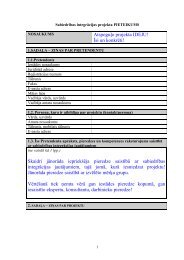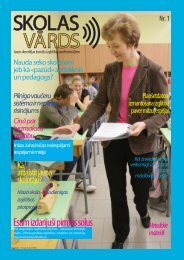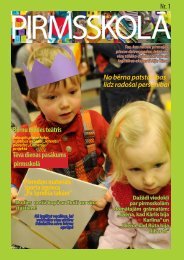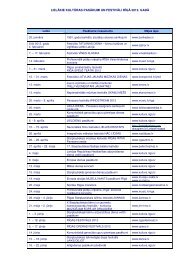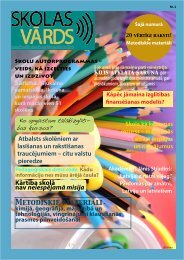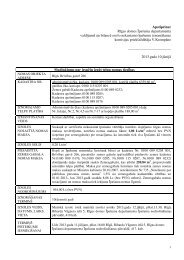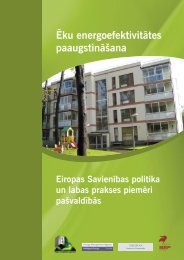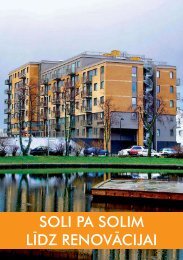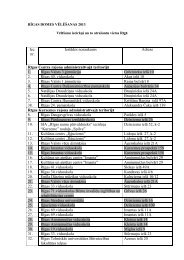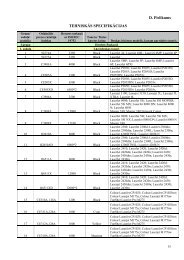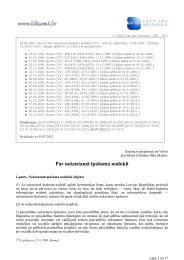Riga - European Capital of Culture 2014 candidate
Riga - European Capital of Culture 2014 candidate
Riga - European Capital of Culture 2014 candidate
- No tags were found...
Create successful ePaper yourself
Turn your PDF publications into a flip-book with our unique Google optimized e-Paper software.
Latvian National LibrarySpīķeri – a quarter for creative industriesLatvian National Library<strong>Riga</strong> Concert HallContemporary Art MuseumThe construction <strong>of</strong> the Latvian National Library is the most significant and large-scalenational initiative <strong>of</strong> the 21 st century in Latvia. The library building, which is figurativelyknown as the ‘Castle <strong>of</strong> Light’ will become both a centre for information, culture andsocial life, and a striking feature <strong>of</strong> the urban environment and a symbol <strong>of</strong> <strong>Riga</strong>. TheLatvian National Library project is supported by UNESCO, which in 1999 adopted a resolutioninviting Member States and the international society to provide as much supportas possible to implement the project. Construction <strong>of</strong> the building commenced in 2008.The ‘Castle <strong>of</strong> Light’ should be open to visitors in 2013. For more information about theproject: www.gaismaspils.lv.<strong>Riga</strong> Concert Hall<strong>Riga</strong> Concert Hall and the Latvian National Library will be situated next to each other,forming a new group <strong>of</strong> cultural facilities on the left bank <strong>of</strong> the River Daugava. TheUNESCO World Heritage Centre has recognised <strong>Riga</strong> Concert Hall as an example <strong>of</strong>quality architecture that will elegantly enhance the new centre <strong>of</strong> the city. <strong>Riga</strong> ConcertHall will not only be a prominent example <strong>of</strong> architecture and a symbol <strong>of</strong> the city, but willalso give its visitors the opportunity <strong>of</strong> enjoying an unrepeatable combination <strong>of</strong> acousticsand technical quality. The building will contain three halls – a Grand Hall for performances<strong>of</strong> academic music, as well as a Small Hall and an Experimental Hall that may beadapted for different genres <strong>of</strong> music. Spacious rooms for the public and rooms for thedaily work <strong>of</strong> musicians, including rehearsals, will be provided in <strong>Riga</strong> Concert Hall. Formore information about the project: www.koncertzale.lv.Contemporary Art MuseumThe Contemporary Art Museum will be established in a historic building – in the formerpower plant on Andrejsala. Over the next few years this former port area will becomea modern and attractive neighbourhood, just as Soho in New York, or Notting Hill inLondon. The Contemporary Art Museum will be a multifunctional cultural centre withexhibition rooms occupying 4 000 m2, a conference and cinema hall, a computerisedinformation centre, a library and archive, as well as rooms for art pedagogy and projectworkshops. The museum will not only reflect the symbols <strong>of</strong> national identity that confirmthe rich Latvian heritage <strong>of</strong> visual art, but will also become a testimony to the significantrole <strong>of</strong> <strong>Riga</strong> in the cultural processes <strong>of</strong> Europe in the 21 st century. At the sametime as developing the construction project <strong>of</strong> the building, the collection for the LatvianContemporary Art Museum is being established – works are being selected by an internationalexpert commission, approved by the Ministry <strong>of</strong> <strong>Culture</strong>. For more informationabout the project: www.camriga.lv.Based on the development plan for the city <strong>of</strong> <strong>Riga</strong>, which envisages the development<strong>of</strong> cultural and recreational functions in the historic warehouse area, Spīķeri, involving theterritory in the social and business infrastructure <strong>of</strong> the city, Spīķeri is becoming a cityquarter for creative industries, developing a cluster <strong>of</strong> high added value. Spīķeri alreadyhouses the unique Doll Art Museum, avant-garde theatre for adults and children, andcontemporary music and cinema events take place in the Dirty Deal Café. Every week,notable festivals and unique concerts make Spīķeri a significant centre for contemporaryculture. It is one <strong>of</strong> the epicentres for events during the city’s most noticeable cultural festivals– “White Nights”, “Poetry Days”, “Radiant <strong>Riga</strong>”. The newly opened boat transportsystem has provided a basis for rejuvenating the Spīķeri embankment.Spīķeri is a complex <strong>of</strong> buildings between Maskava, Turgeņeva and Krasta Streets, andthe Spīķeri embankment, from the old pier <strong>of</strong> the Railway Bridge to Sala Bridge. The industrialaesthetics <strong>of</strong> the territory <strong>of</strong> Spīķeri included in the UNESCO World Heritage listserve as inspiration for developing the quarter.It is hoped that the territory <strong>of</strong> Spīķeri will be transformed into a contemporary, modernand publicly accessible urban environment. Spīķeri will be the home for creative culturalorganisations, contemporary music and cinema events, art galleries, <strong>of</strong>fices, cosyrestaurants and cafés. Spīķeri will be the location for the most outstanding College <strong>of</strong>Gastronomic Arts in the Baltic region and an organic market for Latvian farmers.The future <strong>of</strong> Spīķeri embankment is in high quality designer objects and as a locationfor cultural events, wide options for water sports for all the family, with pedestrian andcyclist-friendly access and as the central hub for <strong>Riga</strong>’s water transport. It is planned thatreconstruction <strong>of</strong> the Spīķeri quarter will finish in 2012, and the improvement <strong>of</strong> Spīķeriembankment will conclude in 2009–2010.Wooden building complex on Kalnciema Street –a commune <strong>of</strong> creative industriesImplementation <strong>of</strong> the private initiative model was commenced in 2004 by Kārlis andMārtiņš Dambergs, in collaboration with architect Liene Griezīte, renovating the ensemble<strong>of</strong> wooden buildings on Kalnciema Street. The Dambergs began their business activitiesby producing recycled wooden floors and this grew into the purchasing and restoring<strong>of</strong> the wooden houses. The NGO Latvia Nostra proposed the street renewal projectto <strong>Riga</strong> City Council in 2002, but a positive turning point in the delayed renewal stagnationprocess took place thanks to the NATO Summit in <strong>Riga</strong>, in November 2006. Prior to thisimportant event, significant government funding was granted, because convoys <strong>of</strong> distinguishedguests could not be taken to the city centre from the international airport withoutpassing the wooden houses on Kalnciema Street, which, at the time, were in a very poorcondition. Today, the commune <strong>of</strong> Kalnciema Street is a lifestyle that has a magnetic attraction,involves people with similar views and brings together like-minded people forinhabiting the houses. The agenda <strong>of</strong> the “Green House Commune” includes a canteenproject, <strong>of</strong> which an organic component will be green markets that will <strong>of</strong>fer locally grownseasonal products.SpīķeriWooden building complex on Kalnciema Street154 155



